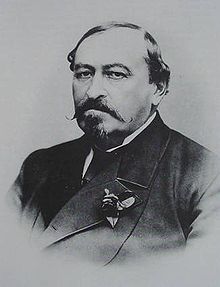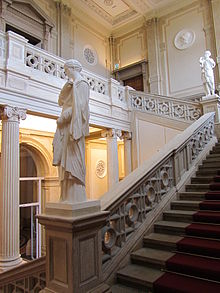Ducal Museum Gotha
The Ducal Museum Gotha , located in the palace park south of Friedenstein Palace , is a neo-Renaissance museum building from the 19th century. Since reopening in 2013, it has shown the art collection of the Dukes of Saxe-Gotha with Egyptian and Greco-Roman antiquities, Renaissance paintings, East Asian art from China and Japan as well as sculptures from different eras. A masterpiece of the exhibition is the Gotha lovers , a painting from 1480.
history
19th century
The constant growth of the ducal collections at Friedenstein Palace, which included a library, a coin cabinet, a natural history cabinet, an art cabinet, a picture gallery and a copper engraving collection, gave rise to a separate, representative new museum building. In 1863, Duke Ernst II of Saxe-Coburg and Gotha commissioned the construction of a new museum with the consent of the Landtag of the Duchy of Saxe-Gotha on condition that it was accessible to the public with free entry on Sundays. The Duke wanted it to contain all collections except for the library. Initially, construction costs of around 120,000 thalers were expected, financed from the domain assets.
In 1864 the Viennese architect and building officer Franz von Neumann the Elder (1815–1888), who had been in the ducal service since 1839, was entrusted with the planning to be built south of Friedenstein Castle on the site of the former ducal kitchen garden . Neumann calculated a construction cost (excluding interior fittings) of 145,000 thalers for a construction period of four years. Construction work began in June 1864.
In 1869, while the museum was being built, work began on the construction of the so-called fir garden south of the building . Starting from the wide flight of stairs on the south terrace of the museum, the Gothic head gardener Carl Theobald Eulefeld (1818–1877) laid out a wide promenade that divides the area of the former kitchen garden into two halves and leads to the southern part of the English Garden with the large park pond . Mainly in the spring of 1872 around 170 conifers of over 40 different varieties from all over the world were planted in groups in the fir garden. The garden's dendrological collection was deliberately designed as a natural "continuation" of the museum's natural history collection and was completed by 1882.
In 1867, the insufficient construction budget had to be increased to 200,000 thalers with the consent of the state parliament. In 1870, construction costs of 400,000 thalers became apparent, in particular for the completion of the interior work, which, due to the unresolved remaining financing, led to the construction work being stopped for four years in November 1870. After the architect agreed to make restrictions and the duke agreed to take over about 70 percent of the missing funds and the state parliament agreed to take over the remaining 30 percent, construction work resumed in May 1875. At the beginning of 1878, when the calculation for the interior work was again exceeded, the construction manager Franz von Neumann was withdrawn from the construction management and the contract was terminated. On April 17, 1879, 15 years after construction began, the house was finally opened. The art cabinet, the Chinese cabinet, the natural history cabinet, the copperplate cabinet, the picture gallery and the collection of plaster casts were housed in it.
20th century
At the end of the Second World War, the collections of the Ducal Museum suffered great losses as a result of relocation, looting and removal. The remaining parts of the art collections were transported to the Soviet Union in 1945 and after their return in 1956 they were housed in Friedenstein Castle. The natural science collections remained in the museum building and were expanded to include the natural history museum. After the renovation of the building, the Central Biological Museum was opened on August 1, 1954 in the former Ducal Museum. The largest natural museum in Thuringia at that time was named Natural History Museum, from 1971 it was the Museum of Nature Gotha .
21st century
As part of a redesign of the Gotha museum landscape, the house was closed in 2010 and the holdings of the natural history collections were gradually relocated to Friedenstein Castle by the end of 2011. After a thorough renovation for nine million euros, the Ducal Museum with 3,000 square meters of exhibition space was reopened on October 19, 2013. The notable treasures include an Egyptian collection, which is considered one of the earliest on the continent, numerous antiques, porcelain from Meissen and Asia, Japanese lacquer objects, sculptures from Gothic to Classicism, including a considerable Houdon collection, Dutch and Old German paintings such as the “ Gotha Lovers ” and numerous works by Lucas Cranach, as well as paintings from Rubens to Caspar David Friedrich. In addition, there is a room for temporary exhibitions in the important Kupferstichkabinett and a special exhibition area for large exhibitions in the foundation museums.
Directors
- Carl Aldenhoven (1879–1890)
- Karl Purgold (1890–1934)
- Eberhard Schenk zu Schweinsberg (1934–1946)
- Bruno Voigt (1946–1954)
- Michel Hebecker (1986–1992)
- Rudolf Funk (1992)
- Klaus Roewer (1995–1997)
- Elisabeth Dobritzsch and Ulrich Mahlau (1997–1998)
- Klaus Roewer (1998–1999)
- Rainer Samietz and Ulrich Mahlau (1999–2001)
- Katharina Bechler (2004-2006)
- Ulrich Mahlau (2006-2007)
- Martin Eberle (2007-2018)
exhibition
The exhibition shows ancient and Egyptian art as well as Italian cork models of ancient buildings from the 18th century in the basement . The sculpture hall and another hall for temporary exhibitions are located on the ground floor. Paintings are on display on the upper floor, with a focus on works by Dutch masters (Renaissance) and Lucas Cranach the Elder. Ä. lies. There are also collections of East Asian art, which include Chinese porcelain, Japanese lacquer work, and more.
Gotha lovers , 1480
Christ and Maria Magdalena, Lucas Cranach d.Ä. , 1516-20
Damnation and redemption, Lucas Cranach the Elder , 1529
Gotha table altar , 1540
Cross in the Mountains, Caspar David Friedrich , 1823
Portrait of an Unknown Man, Abraham de Vries , 1643
Teapots from Yixing , 18th century
architecture
Franz von Neumann based his plans on existing new museum buildings from the first half of the 19th century, but at the same time also realized his own ideas, which in turn became groundbreaking for later buildings. Versailles was certainly the most important inspiration for the design of the facade. The masonry consists mostly of Seeberg sandstone, some stones from Pirna in Saxony were also used . The middle part is particularly emphasized by a glass dome in the middle of the building, the representative main entrance and the pavilion-like design of the corners. Two seated lions modeled by the sculptor Franz Melnitzky on the outside staircase and two allegorical sandstone statues in the entrance portal welcome the visitor. On the corners of the attic there are groups of figures that symbolize art and science.
Inside, the path to the halls and cabinets leads through a magnificent, very clearly structured vestibule . Italian marble and a multi-colored stone mosaic determine the overall appearance of the room. In the basement there are a number of small cabinets, above on the ground floor there are two generous, light-flooded columned halls and on the upper floor there are skylight halls, which are in turn surrounded by cabinets. The glass dome is erected over a central octagon , in the middle of which stands a life-size bronze sculpture of Ernst II dressed as a knight from the Order of the Garter , which was designed by the sculptor Christian Behrens in 1882.
Others
The building is owned by the city and the museum is looked after by the Schloss Friedenstein Gotha Foundation, which has existed since 2004 . Martin Eberle has been the director of the foundation since 2007.
literature
- Martin Eberle: Ducal Museum Gotha. Münzkabinett, Kupferstichkabinett, East Asia . Mitteldeutscher Verlag, Halle (Saale) 2013, ISBN 978-3-95462-017-3 .
- Schloss Friedenstein Gotha Foundation (ed.): Museums of the Schloss Friedenstein Gotha Foundation: Castle Museum, Museum of Nature, Museum of Regional History and Folklore. Deutscher Kunstverlag, Munich / Berlin 2007, ISBN 978-3422066205
- Wolfgang Zimmermann: The construction of the Ducal Museum in Gotha (1864–1879) . In: Harald Bachmann, Wener Korn, Helmut Claus, Elisabeth Dobritzsch (eds.): Duke Ernst II of Saxe-Coburg and Gotha, 1818–1893 and his time , anniversary publication on behalf of the cities of Coburg and Goth. Maro Verlag, Augsburg 1993, ISBN 3-87512-198-8 , pp. 249-261.
Web links
- Ducal Museum Gotha . In: StiftungFriedenstein.de
- Ducal Museum Gotha . In: Museen.Thueringen.de
- Ducal Museum Gotha . In: Museum.de
- Website of the Freundeskreis Kunstsammlungen Schloss Friedenstein Gotha eV
Coordinates: 50 ° 56 ′ 36 ″ N , 10 ° 42 ′ 21 ″ E
Individual evidence
- ^ Architekturzentrum Wien - Architects Lexicon: Franz Neumann d. Ä.
- ↑ a b Jens Scheffler: The facilities at the New Museum (Tannengarten). In: In the realm of the goddess freedom. Gotha's princely gardens in five centuries , Gotha 2007, p. 189ff.
- ^ Wolfgang Zimmermann: The construction of the Ducal Museum in Gotha (1864–1879)
- ↑ Homepage Stiftung Schloss Friedenstein Gotha: Ducal Museum Gotha: opening on October 19, 2013 , accessed on October 20, 2013
- ↑ Homepage of the Central German Publishing House , accessed on October 20, 2013

















